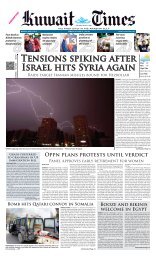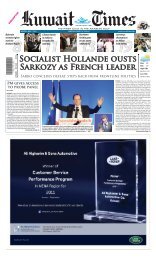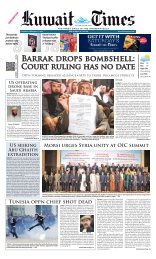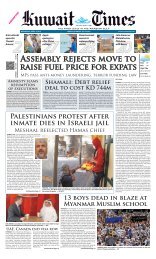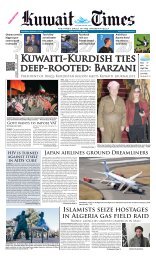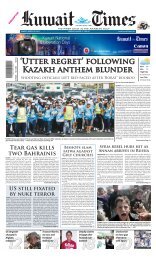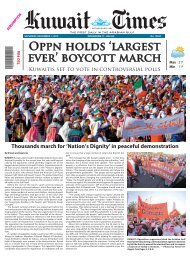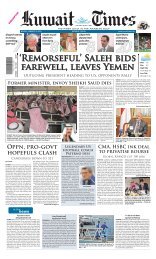NEw SARS-likE viRUS EMERGES iN MidEASt - Kuwait Times
NEw SARS-likE viRUS EMERGES iN MidEASt - Kuwait Times
NEw SARS-likE viRUS EMERGES iN MidEASt - Kuwait Times
You also want an ePaper? Increase the reach of your titles
YUMPU automatically turns print PDFs into web optimized ePapers that Google loves.
EXCHANGE RATES<br />
Commercial Bank of <strong>Kuwait</strong><br />
US Dollar/KD .2740000 .2860000<br />
GB Pound/KD .4500000 .4610000<br />
Euro .3600000 .3720000<br />
Swiss francs .2970000 .3070000<br />
Canadian Dollar .2840000 .2940000<br />
Australian DLR .2900000 .2990000<br />
Indian rupees .0040000 .0058500<br />
Sri Lanka Rupee .0020000 .0035000<br />
UAE dirhams .0760680 .07678320<br />
Bahraini dinars .7411030 .7485520<br />
Jordanian dinar .3870000 .4100000<br />
Saudi riyals .0720000 .0780000<br />
Omani riyals .7265200 .7338210<br />
Egyptian pounds .0430000 .0510000<br />
CUSTOMER TRANSFER RATES<br />
US Dollar/KD .2802000 .2823000<br />
GB Pound/KD .4543300 .4577350<br />
Euro .3627190 .3654370<br />
Swiss francs .2998070 .3020540<br />
Canadian dollars .2862540 .2884000<br />
Danish Kroner .0486530 .0490170<br />
Swedish Kroner .0425670 .0428860<br />
Australian dlr .2919960 .2941850<br />
Hong Kong dlr .0361410 .0364120<br />
Singapore dlr .2283800 .2300920<br />
Japanese yen .0035900 .0036170<br />
Indian Rs/KD .0000000 .0053310<br />
Sri Lanka rupee .0000000 .0021600<br />
Pakistan rupee .0000000 .0029970<br />
Bangladesh taka .0000000 .0034730<br />
UAE dirhams .0763180 .0768900<br />
Bahraini dinars .7435230 .7491040<br />
Jordanian dinar .0000000 .3992930<br />
Saudi Riyal/KD .0747400 .0753000<br />
Omani riyals .7280760 .7335330<br />
Philippine Peso .0000000 .0068070<br />
BUSINESS<br />
Hamas halves Israeli fruit imports to Gaza<br />
GAZA: The Hamas government has barred much of<br />
Gaza’s fruit imports from Israel, citing a need to cultivate<br />
local Palestinian agriculture and for “resistance”<br />
against the Jewish state. The ban is opposed by<br />
Gazan produce traders who fear a squeeze on supplies<br />
and price hikes in the poor coastal enclave,<br />
which has a largely black market economy and lacks<br />
viable trade with Egypt, its other neighbour. Local<br />
growers however said the move would help them.<br />
With the exception of bananas and apples, Gaza is<br />
no longer admitting fruit from Israel, the Agriculture<br />
Ministry said yesterday. The ban affects at least seven<br />
kinds of fruit and, in terms of sales, constitutes around<br />
a 50 percent cut in imports whose 2011 value the<br />
ministry put at $26 million.<br />
Tahseen Al-Saqqa, the ministry’s director of marketing,<br />
said the move was in part a response to what<br />
he described as Israel’s refusal to allow the export,<br />
through its border with Gaza, of staple Palestinian<br />
BANGKOK: A man checks his mobile phone (lower right) as he walks on a footbridge<br />
yesterday. The Thai economy is experiencing a solid growth after suffering a doubledigit<br />
contraction in the wake of the kingdom’s worst floods in decades at the end of<br />
2011. — AP<br />
Iran opens forex centre<br />
to support sagging rial<br />
DUBAI: Iran launched a fresh bid yesterday<br />
to stabilise its falling currency,<br />
opening a foreign exchange centre that<br />
provides government-subsidised US<br />
dollars to import some goods as the<br />
country struggles with Western economic<br />
sanctions. The rial’s street value<br />
has tumbled by more than half in the<br />
last year because of US and European<br />
sanctions against Iran’s oil and banking<br />
sectors, which have cast doubt on the<br />
central bank’s ability to defend its currency.<br />
Iranians have rushed to informal<br />
money changers to convert their savings<br />
into hard currencies, driving down<br />
the rial’s open-market value. This has<br />
raised the price of imported goods,<br />
contributing to double-digit inflation.<br />
The new foreign exchange centre<br />
allows importers of goods including<br />
truck tyres, construction equipment<br />
and synthetic fibres to buy dollars at a<br />
rate 2 percent cheaper than the street<br />
rate at any given time.<br />
The government plans to use revenues<br />
from petrochemical sales and<br />
14.5 percent of its oil revenues to provide<br />
dollars for the centre, central bank<br />
governor Mahmoud Bahmani said on<br />
Sunday, according to the newspaper<br />
Aftab.<br />
He did not give an absolute figure<br />
for the amount of dollars to be supplied.<br />
“With the distribution of currency<br />
in this centre, the exchange rate in the<br />
market will go down, because some of<br />
<strong>Kuwait</strong> Bahrain Intl Exchange Co.<br />
Currency Rate per 1000 (Tran)<br />
US Dollar 280.900<br />
Pak Rupees 2.968<br />
the demand (for dollars) will be met in<br />
this centre and the pressure of demand<br />
will be removed,” Bahmani was quoted<br />
as saying.<br />
The dollar sold for 24,040 rials at the<br />
centre yesterday, the Iranian Students’<br />
News Agency said, compared to about<br />
24,600 on the open market at around<br />
the same time, according to currencytracking<br />
website Mesghal. The foreign<br />
exchange centre is the latest in a series<br />
of plans floated by the government in<br />
the last three months to address a burgeoning<br />
currency crisis, for which legislative<br />
foes of President Mahmoud<br />
Ahmadinejad have blamed his administration.<br />
The government maintains an official<br />
“reference” rate of 12,260 rials to the<br />
dollar, but only a limited amount of foreign<br />
exchange is available at this rate.<br />
Iran’s oil sales, its chief source of hard<br />
currency, have plummeted this year as<br />
a result of the sanctions, and legislators<br />
accused the central bank earlier this<br />
month of not injecting enough dollars<br />
into the market, thereby contributing<br />
to a fresh fall in the rial. The foreign<br />
exchange centre appears to have<br />
replaced a previous plan to establish a<br />
currency trading market, a proposal<br />
that was fiercely criticised by the private<br />
sector, which said the scheme<br />
would simply introduce yet another<br />
rate for the rial and bring more chaos to<br />
the economy. — Reuters<br />
fruit like grapes and guavas. “The Palestinian farmer is<br />
suffering because all doors to export have been<br />
closed,” Saqqa said.<br />
The charge was denied by Israel, which limits traffic<br />
in and out of Gaza and whose dealings with<br />
Palestinians there are often circuitous given long-running<br />
hostilities with Islamist Hamas. “I know of no<br />
request to export agriculture products from Gaza that<br />
has been refused,” said Guy Inbar, spokesman for the<br />
division in Israel’s Defence Ministry which liaises with<br />
the Palestinian territories.<br />
Price of war<br />
Gaza fruit importer Jaber Al-Shanty said the Hamas<br />
government ban was “irresponsible and unrealistic” as<br />
it overlooked the losses to hundreds of Palestinians<br />
whose livelihood depends on marketing the fruit.<br />
“The local product is not nearly enough” to offset the<br />
shortfall, he said. “What do we have in large quanti-<br />
Indian Rupees 5.190<br />
Sri Lankan Rupees 2.130<br />
Bangladesh Taka 3.427<br />
Philippines Peso 6.770<br />
UAE Dirhams 76.580<br />
Saudi Riyals 75.065<br />
Bahraini Dinars 746.800<br />
Egyptian Pounds 46.125<br />
Pound Sterling 461.800<br />
Indonesian Rupiah 2.990<br />
Yemeni Riyal 1.550<br />
Euro 373.700<br />
Canadian Dollars 294.200<br />
Nepali rupee 3.200<br />
Al Mulla Exchange<br />
Currency Transfer Rate (Per 1000)<br />
US Dollar 280.900<br />
Euro 367.100<br />
Pound Sterling 458.250<br />
Canadian Dollar 290.100<br />
Japanese Yen 3.650<br />
Indian Rupee 5.247<br />
Egyptian Pound 46.119<br />
Sri Lankan Rupee 2.138<br />
Bangladesh Taka 3.438<br />
Philippines Peso 6.740<br />
Pakistan Rupee 2.980<br />
Bahraini Dinar 747.900<br />
UAE Dirham 76.500<br />
Saudi Riyal 74.950<br />
*Rates are subject to change<br />
UAE Exchange Centre WLL<br />
COUNTRY SELL DRAFT SELL CASH<br />
Australian Dollar 297.03 297.000<br />
Canadian Dollar 291.30 290.500<br />
Swiss Franc 305.15 305.000<br />
Euro 366.43 366.000<br />
US Dollar 281.00 282.000<br />
Sterling Pound 458.65 459.000<br />
Japanese Yen 3.68 3.690<br />
LONDON: Gold prices eased nearly 1 percent<br />
yesterday, pulling back from the previous session’s<br />
6-1/2 month high, as the dollar rose and<br />
assets seen as higher risk, like stocks, the euro<br />
and other commodities like crude oil retreated.<br />
The metal remained underpinned however,<br />
by expectations for longer-term price<br />
strength, after central banks including the<br />
Federal Reserve and European Central Bank<br />
announced fresh rounds of monetary policy<br />
easing earlier this month. Spot gold was<br />
down 0.7 percent at $1,760.00 an ounce at<br />
1219 GMT, while US gold futures for<br />
December delivery were down $15.30 an<br />
ounce at $1,762.70. On Friday gold hit a peak<br />
of $1,787.20, its highest since Feb 29. The Fed<br />
this month launched a third round of quantitative<br />
easing - printing money to buy bonds -<br />
under which it will purchase $40 billion a<br />
month in mortgage-backed debt until the<br />
outlook for the labour market improves substantially.<br />
Further monetary easing is likely to<br />
maintain pressure on long-term interest rates,<br />
keeping the opportunity cost of holding gold<br />
at rock bottom, and to undermine the dollar,<br />
boost liquidity, and stoke fears over inflation<br />
further down the line. However, a stronger<br />
dollar and caution among investors over the<br />
uncertain outlook for Europe has put the<br />
brakes on gold.<br />
“Part of the issue is the lack of obvious catalysts<br />
in the near term to take gold prices<br />
higher,” Deutsche Bank analyst Daniel Brebner<br />
said. “We have some continuing risk issues in<br />
Europe, US manufacturing data continues to<br />
be for the most part disappointing, and<br />
ties, other than guava?”<br />
Shanty said he and other importers had made<br />
advance payments to Israeli suppliers that would now<br />
be difficult to claim back. Hikmat Abu Al-Qombuz,<br />
another importer, predicted spiralling fruit prices -<br />
which Gaza, most of whose 1.6 million Palestinians<br />
depend on aid, can ill afford. Gaza dates and guava<br />
grower Ibrahim Al-Shaer, 52, said the move would<br />
help farmers by raising prices. But he admitted some<br />
imports from Israel remained vital.<br />
“Israeli fruits compete with our produce in the market<br />
and they push down the prices. The government<br />
should allow imports at a reasonable level so the<br />
prices of our fruits do not go down sharply,” Shaer said<br />
as he stood in his field in Mawasi in southern Gaza.<br />
Since the import ban went into effect on Friday, the<br />
price of peaches has doubled to eight Israeli shekels<br />
($2) a kilo, while dates were selling at 11 shekels<br />
($2.81) a kilo, up from 7 shekels.<br />
Bangladesh Taka 3.440 3.560<br />
Indian Rupee 5.071 5.450<br />
Sri Lankan Rupee 2.147 2.290<br />
Nepali Rupee 3.313 3.530<br />
Pakistani Rupee 2.976 3.150<br />
UAE Dirhams 76.57 77.250<br />
Bahraini Dinar 748.21 748.000<br />
Egyptian Pound 46.18 47.650<br />
Jordanian Dinar 400.33 398.100<br />
Omani Riyal 731.33 735.000<br />
Qatari Riyal 77.60 78.000<br />
Saudi Riyal 75.14 75.500<br />
Dollarco Exchange Co. Ltd<br />
Rate for Transfer Selling Rate<br />
US Dollar 281.350<br />
Canadian Dollar 288.170<br />
Sterling Pound 457.640<br />
Euro 365.405<br />
Swiss Frank 301.475<br />
Bahrain Dinar 744.865<br />
UAE Dirhams 76.580<br />
Qatari Riyals 77.225<br />
Saudi Riyals 74.990<br />
Jordanian Dinar 396.605<br />
Egyptian Pound 46.197<br />
Sri Lankan Rupees 2.143<br />
Indian Rupees 5.284<br />
Pakistani Rupees 2.972<br />
Bangladesh Taka 3.438<br />
Philippines Pesso 6.744<br />
Cyprus pound 690.150<br />
Japanese Yen 4.600<br />
Thai Bhat 9.215<br />
Syrian Pound 4.365<br />
Nepalese Rupees 3.385<br />
Malaysian Ringgit 91.705<br />
Chinese growth continues to be a real risk as<br />
well in the near term.”<br />
“So there are a number of low growth concerns<br />
which could underpin the dollar, and<br />
keep gold somewhat moribund near term.”<br />
“But I do think we will likely see over the next<br />
quarter or so greater policy action both in<br />
Europe and China to support growth within<br />
those regions,” he added. “The likelihood is for<br />
further accommodative monetary policy in<br />
both regions, and that could keep the gold<br />
price moving higher. We think we will see<br />
$2,000-plus gold prices in the first half of next<br />
year.” European shares and the euro followed<br />
a broad range of riskier assets lower yesterday<br />
as investors refocused attention from central<br />
bank stimulus schemes to weak economic<br />
fundamentals and the euro zone’s yet-to-beresolved<br />
debt crisis. Brent crude fell below<br />
$110 a barrel, dragged down by a firm dollar<br />
and worries over weak global growth after<br />
disappointing German data, while copper hit<br />
a one-week low.<br />
Holdings of gold-backed exchange-traded<br />
funds tracked by Reuters rose by nearly<br />
330,000 ounces on Friday to 73.748 million<br />
ounces, climbing back towards last week’s<br />
record high at 73.681 million ounces. The bulk<br />
of inflows were seen into the world’s largest<br />
gold ETF, New York’s SPDR Gold Trust. ETFs,<br />
which issue securities backed by physical metal,<br />
have proved a popular way to invest in gold<br />
in recent years.<br />
Meanwhile, demand in major consumer<br />
India picked up, as a drop in local gold prices to<br />
a three-week low yesterday prompted a wave<br />
Bahrain Exchange Company<br />
COUNTRY SELL CASH SELL DRAFT<br />
Australian dollar 296.900 295.400<br />
Bahraini dinar 748.490 748.490<br />
Bangladeshi taka 3.680 3.434<br />
TUESDAY, SEPTEMBER 25, 2012<br />
Saqqa said the Hamas government would crack<br />
down on any Gazans deemed to be gouging fruit<br />
prices, and urged Palestinians to view the hardship<br />
through the prism of their struggle against Israel.<br />
“We are people under blockade and we should<br />
have the culture of resistance,” he said. “Why should<br />
someone have all kinds of fruits on his table?” Hamas<br />
won a Palestinian ballot in 2006, and had an uneasy<br />
alliance with the Western-backed rival Palestinian faction<br />
Fatah until they fought a brief civil war in Gaza a<br />
year later. Under Hamas rule since, Gaza has suffered<br />
an often grinding embargo by Israel and Egypt, alleviated<br />
by goods smuggled in through tunnels from the<br />
Egyptian Sinai.<br />
Israel, which fought a three-week war with Gaza in<br />
2008-2009, eased overland travel restrictions in mid-<br />
2010. Hamas has urged Egypt to open up its border<br />
with Gaza since Islamists swept to power in Cairo this<br />
year but the call has not been met. — Reuters<br />
Gold retreats from 6-1/2<br />
month high as dollar firms<br />
Monetary easing measures support gold near highs<br />
Canadian dollar 291.300 289.800<br />
Cyprus pound 552.800<br />
Czek koruna 45.900<br />
Danish krone 49.900<br />
Deutsche Mark 167.800 231.200<br />
Egyptian pound 48.080 46.183<br />
Euro Cash 368.700 367.200<br />
Hongkong dollar 36.970 36.820<br />
Indian rupees 5.390 5.280<br />
Indonesia 0.032 0.031<br />
Iranian tuman 0.161<br />
Iraqi dinar 0.235<br />
Japanese yen 3.700<br />
Jordanian dinar 398.850 398.810<br />
Lebanese pound 0.190 0.189<br />
Malaysian ringgit 94.100 94.100<br />
Morocco dirham 45.300<br />
Nepalese Rupees 4.330 3.320<br />
New Zealand dollar 235.700 234.200<br />
Nigeria 1.823<br />
Norwegian krone 50.300<br />
Omani Riyal 731.070 730.890<br />
Pakistani rupees 3.070 2.979<br />
Philippine peso 7.000 6.764<br />
Qatari riyal 77.850 77.420<br />
Saudi riyal 75.150 75.150<br />
Singapore dollar 231.180 231.180<br />
South Africa 36.340 36.340<br />
Sri Lankan rupees 2.681 2.144<br />
Sterling pound 460.300 458.300<br />
Swedish krona 43.800<br />
Swiss franc 304.600 303.100<br />
Syrian pound 4.300 4.300<br />
Thai bhat 9.470 9.300<br />
Tunisian dollar 198.263<br />
UAE dirham 76.740 76.640<br />
U.S. dollars 281.800 281.400<br />
Yemeni Riyal 1.350<br />
10 Tola 1,872.350<br />
of buying, while an upcoming week-long holiday<br />
in China has generated some physical gold<br />
buying interest. “Buying interest is much higher<br />
than last week, mostly because the rupee has<br />
appreciated substantially,” one Mumbai-based<br />
dealer said, adding that physical demand<br />
might be sustained if prices - at 31,281 rupees<br />
per 10 grams earlier yesterday - held below<br />
32,000 rupees.<br />
Among other precious metals, silver was<br />
down 1.8 percent at $33.79 an ounce. The<br />
gold/silver ratio, which measures the number<br />
of silver ounces needed to buy an ounce of<br />
gold, recovered from last week’s 5-1/2 month<br />
low at 50.9 to 51.9 yesterday, after silver underperformed<br />
the yellow metal late last week.<br />
Technical analysts at ScotiaMocatta, who study<br />
past price moves for clues as to the future<br />
direction of prices, said they expect the ratio to<br />
continue falling. “While the ratio has been consolidating<br />
the past week, the larger trend<br />
remains bearish, with an initial target at the<br />
March low of 47.67,” it said. Spot platinum was<br />
down 1.7 percent at $1,608.99 an ounce,<br />
while spot palladium was down 4.4 percent<br />
at $639.47 an ounce, on track for its biggest<br />
one-day drop since early March. Some of the<br />
premium attached to platinum group metals<br />
by labour unrest in South Africa has dissipated,<br />
analysts said. Industrial unrest in major<br />
platinum producer South Africa has simmered<br />
down during a national holiday in the<br />
republic, after weeks of sometimes violent<br />
protest killed 45 and sent the metal to multimonth<br />
highs. Tensions remain elevated, however.<br />
— Reuters<br />
Britons’ inflation fears rise again<br />
LONDON: Britons’ worries about inflation<br />
grew this month, though their view of their<br />
future finances was the least pessimistic in 2-<br />
1/2 years, a survey showed yesterday. The<br />
Markit Household Finance Index (HFI) dipped<br />
to 38.4 in September from August’s 20-month<br />
high of 38.9, indicating that consumers’<br />
finances worsened over the month as the<br />
index was well below the 50 mark that would<br />
mark no change.<br />
The latest reading was still one of the<br />
highest in the past two years, and households<br />
reported a reduced squeeze on their<br />
savings and cash available to spend, survey<br />
compiler Markit said. “September’s survey<br />
suggests that the gradual easing of pressure<br />
on real incomes so far in 2012 continues to<br />
support household finances,” said Markit<br />
economist Tim Moore.<br />
Forty percent of those surveyed anticipated<br />
a worsening in their finances in the next<br />
12 months, while 29 percent expected an<br />
improvement - making it the least downbeat<br />
financial outlook since March 2010. “However,<br />
households appear to have become more<br />
concerned about the inflation outlook, with<br />
cost of living expectations rising sharply<br />
since August,” Moore said.<br />
Around three-quarters of the survey<br />
respondents noted that their costs of living<br />
had increased since August and the monthon-month<br />
rise in the index measuring inflation<br />
perceptions was the greatest since<br />
January 2011. The index for inflation expectations<br />
posted the strongest month-on-month<br />
rise since November 2010, hitting the highest<br />
level since May.<br />
Britons have cut back spending as high<br />
inflation, tax increases and slow wage rises<br />
have put the tightest squeeze on incomes for<br />
more than 30 years, keeping consumer<br />
morale low.<br />
The Bank of England and the government<br />
are hoping that lower inflation will ease the<br />
pressure and enable households to spend<br />
more. Inflation has fallen from the high of 5.2<br />
percent last year to 2.5 percent in August, but<br />
higher oil and commodity prices have stoked<br />
fresh inflation concerns. Some central<br />
bankers have voiced doubts about whether<br />
more monetary stimulus in form of government<br />
bond purchases might be appropriate<br />
once the current round is completed in<br />
November. — Reuters<br />
GOLD<br />
TRAVELLER’S CHEQUE<br />
Sterling Pound 458.300<br />
US Dollar 281.400



